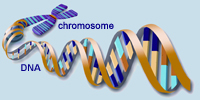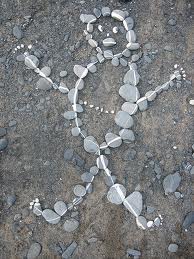|
 Genetic research is widely used to identify and analyze practically all living and once living things. It is probably best known as a forensic tool used to positively connect certain evidence from a crime scene to a particular person. Genetics is also used in a wide variety of other ways, especially as it's medical implications are better understood. It is also being used with great success and importance in ancestral research and with genealogy. Genetic research is widely used to identify and analyze practically all living and once living things. It is probably best known as a forensic tool used to positively connect certain evidence from a crime scene to a particular person. Genetics is also used in a wide variety of other ways, especially as it's medical implications are better understood. It is also being used with great success and importance in ancestral research and with genealogy.
Genetics when used with genealogy, is not the stuff of eye color, physical features or medical information. DNA testing is focused exclusively on information that can show ethnic make up, ancestral homelands and migrations, prove individual connections to other individuals, establish family groupings and ancestral lineages. It is a serious and complicated science, which can be used in various depths and complexity and is completely trusted by the genealogist and scientific community alike. Genetics can be extremely important to personal and family genealogy because it can scientifically prove connections we otherwise might know only from a collection of documents, references and memorabilia, which in some cases might otherwise be considered questionable or incomplete.
Genetics with genealogy is accomplished by testing DNA from living people and comparing those results with results from other living or sometimes deceased people similarly tested. It is from these comparisons that conclusions can be made. These "DNA tests" are now quite common, reasonably affordable and accessible to almost anyone who is willing to participate.
Early genetic testing had an immediate impact on all Jam?sons, everywhere. It quickly proved that there are several genetically different people and families, at least as to ancestral lineages, who use the same Jam?eson surname, and not just one or two, but many. More importantly to our Jam?son family is that we have been able to identify our particular family's indisputable Y-DNA profile, from which all other men in this entire universe can be tested for a match, or mismatch.
Several other examples of just how effective genetics testing can be with genealogy research can be found within our own Jam?son family. We can now say with a high degree of confidence, that Thomas and Hugh Jam?son were brothers, as had long been thought, but could never likely be otherwise proven. We can now also say that William Jameson was not a brother, nor was he related in any way to our family, contrary to what had been thought for some time. We can also say that the Y-DNA results from our Jameson family and the Y-DNA results from the Irish Whiskey Jameson family are similar enough to suggest there was probably some common ancestor between our two families and that was likely to be somewhere in Scotland, between the twelfth century, when surnames were first used, and the 16th century where after the Whiskey Jamesons are otherwise accounted for without any apparent connection with our family.
SOME SPECIFICS about DNA Testing
There are currently three basic DNA tests available with respect to genetics and genealogy, autosomal (atDNA), which tests for all ancestry; mitochondrial DNA (mtDNA), which tests a man or woman along their direct maternal line; and Y-Chromosome (Y-DNA), which tests a male along his direct paternal line.
Any of these tests can be used to some degree for recent genealogy or for ethnic ancestry. For our purposes - determining the history, ancestry and complete content of our particular Jam?son family - Y-DNA testing is the best use of genetics. The Y-DNA chromosome found in living male descendants is basically identical for thousands of years. Any male Jam?son with a Y-DNA profile that matches what we have determined to be "our family," regardless of where he is or how his linage unfolds, can reliably say he is part of our unique Jam?son family.
 - Click here for our Jam?son Y-DNA details and test results - Click here for our Jam?son Y-DNA details and test results
|
|
OUR ANCIENT HISTORICAL PROFILE - Our Haplogroup
  All male humans alive today can be classified into a specific Y-DNA Haplogroup in the Y-DNA Haplotree based on SNP markers found in their Y-DNA. By examining SNPs from indigenous individuals from around the world, scientists can estimate the time and location each SNP first occurred. Once the time and location of occurrence of the SNP is known, it becomes a "time and date stamp" which can be used to trace ancestry. All male humans alive today can be classified into a specific Y-DNA Haplogroup in the Y-DNA Haplotree based on SNP markers found in their Y-DNA. By examining SNPs from indigenous individuals from around the world, scientists can estimate the time and location each SNP first occurred. Once the time and location of occurrence of the SNP is known, it becomes a "time and date stamp" which can be used to trace ancestry.
Human Y-DNA Haplogroups are named using the letters of the alphabet, A to T. Each Y-DNA Haplogroup can be further subclassified into finer branches called subclades. Subclades are named using numbers and lower case letters. For example, I2b1a is a subclade of Haplogroup I (that's "I" as in the capital letter "I" - eye). Haplogroups are also further divided by even smaller groups of people who share a common change (mutation) at a certain marker. This is usually expressed as a number proceeded by a "M" therefore the identifier "M123" means a mutation at marker "123" A minor mutation, or a mutated group with a limited resulting population, is rarely created as a new Haplogroup. Therefore, each Haplogroup usually contains many distinct families with similar, although not exact, YDNA profiles.
We know from YDNA testing that our particular Jam?son family falls into a general grouping known as Haplogroup "I1" with a mutation identified at "M253" often referred to as I1-M253. Our Halpogroup I1 was itself an offshoot, or subclade of Halpogroup "I" with a mutation "M170." Before that we believe our Haplogroup was "F" mutation "M89" which itself was derived from Haplogroup "CT" mutation identified at "M168." It is from here researchers think "Eurasian Adam" may have been our oldest common, ancestor, who was thought to be alive some 31,000 to 79,000 years ago in Africa.
Haplogroup I1, and in particular I1-M253 (and therefore our particular Jam?son family) is somewhat of a lesser player worldwide, as far as size goes, considerably smaller than other groups such as the R1 Haplogroup. It is however a major player in Europe, particularly northern Europe, where it is fairly widespread. Nevertheless, our group, I1, like all others, has it's beginnings on the African continent, maybe 50,000 years ago, or longer.
Some claim that our group within the group (I1-M253) would first be found in the Iberian Refugia (Spain), some 15,000 to 20,000 years ago, during the last ice age. Migration patterns, after the ice finally began its slow retreat, show a northern movement through France and then on to a northeastern loop into what is now Germany and Denmark, then into all of Scandinavia Interestingly this migration loop continued from northeastern Europe and Scandinavia westward, back into the British Isles. 
Noted Haplogroup I1 specialist, Professor Ken Nordtvedt, believes the most recent common ancestor (MRCA) lived from 4,000 to 6,000 years ago somewhere in the far northern part of Europe, perhaps Denmark. Therefore our particular M253 (mutated) ancestors were not as old as originally thought. Subsequent migration and settlement data however doesn't seem to be in dispute.
I1-M253 et al, has it's greatest frequency and density in Scandinavia, Iceland, and northern Europe. In Britain, this nomenclature is sometimes referred to as an identifier for "invaders," Mostly this means the Anglo-Saxon, but would probably also apply to the Vikings, especially in northern England and in Scotland.
It is impossible to know exactly when or from where our ancestors first arrived in the British Isles. It was most likely by way of the Vikings from Scandinavia, as early as the latter part of the ninth or tenth century. It could have been the Anglo Saxon invasion of Britain in the fourth of fifth century, or perhaps from northern France at the time of the Norman Conquest. It is however safe to say they were certainly in Scotland before the time of surnames, in the twelfth or thirteenth century. Long enough ago to now be considered as an integral and structural part of that ethnicity.
  In the last few years DNA testing for use with researching family histories and genealogy, has become widely available, affordable and as such a unique and important toot. There are now several very reputable labs who do this specifically for genealogy as well as groups who have organized for unique family projects. In the last few years DNA testing for use with researching family histories and genealogy, has become widely available, affordable and as such a unique and important toot. There are now several very reputable labs who do this specifically for genealogy as well as groups who have organized for unique family projects.
We test for the Y Chromosone and use the Family Tree DNA - Genealogy by Genetics, Ltd. company.This type of DNA testing helps us understand and focus on the patriarchal nature and family grouping of our specific Jam?son family. We are part of several DNA Projects including: The Jamieson Family DNA Project, the Gunn Sept List DNA Project, the Clan Stewart DNA Project, the Ulster (Ireland) Heritage DNA Project, the Scotland DNA Project, and the Haplogroup I1 Project.
We urge every Jam?son male descendant (must have the Jam?son surname) to help find your own ancestors with this DNA program. Please read this page of answers about DNA testing and then contact us about how to coordinate your results.
 - for information on how to get started. - for information on how to get started.
|